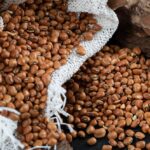Sclerotinia head rot is a fungal disease that affects sunflowers. It is caused by the fungus Sclerotinia sclerotiorum and can result in significant yield losses. Here are some symptoms of Sclerotinia head rot that you should look out for in sunflowers:
- Water-soaked Lesions: The disease initially appears as water-soaked lesions on the back of the sunflower head (capitulum). These lesions are typically grayish-white or tan in color.
- White Fungal Growth: As the disease progresses, a white, cottony fungal growth may develop on the surface of the lesions. This growth consists of mycelium, which is the vegetative part of the fungus.
- Sclerotia Formation: Sclerotia are hard, black structures produced by the fungus. In Sclerotinia head rot, they usually develop within the sunflower head and become visible as the disease advances. These sclerotia are irregularly shaped and resemble small black seeds.
- Shriveled Seeds: Infected sunflower heads may contain shriveled, discolored seeds. The seeds may become lightweight and have a rough, sunken appearance.
- Rotted Stem: In some cases, Sclerotinia head rot can also cause stem rot. The stem may become soft, discolored, and rotted near the base of the plant.
It’s important to note that these symptoms may vary depending on the stage of disease development and environmental conditions. If you suspect Sclerotinia head rot in your sunflowers, it’s advisable to consult with a local agricultural extension service or plant pathologist for an accurate diagnosis and appropriate management recommendations.







